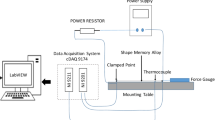Abstract
The purpose of this study is to design and control a thick shape memory alloy (SMA) actuator to achieve rapid position control with two connected SMA wires. In the past, research has focused on position and force control of thin SMA wires, because they cool rapidly in air and as it is easy to get rapid response for SMA actuators in this manner. However, the cooling time is longer with thick SMA wires, making it difficult to obtain rapid position responses with traditional displacement feedback control methods. Phase resistance and displacement feedback control (PRDFC), combing phase resistance and displacement as feedback, minimizes cooling time by shortening the latency duration of thick SMA wires, and experimental results here show that more rapid responses are achieved using the method proposed here than when only displacement is used as feedback.
Similar content being viewed by others
References
Hino, T. and Maeno, T., “Development of a Miniature Robot Finger with a Variable Stiffness Mechanism using Shape Memory Alloy, International Simposium on Robotics and Automation,” International Simposium on Robotics and Automation, 2004.
Ashrafiuon, H., Eshraghi, M., and Elahinia, M. H., “Position Control of a Three-Link Shape Memory Alloy Actuated Robot,” Journal of Intelligent Material Systems and Structures, Vol. 17, No. 5, pp. 381–392, 2006.
Chu, W. S., Lee, K. T., Song, S. H., Han, M. W., Lee, J. Y., and et al., “Review of Biomimetic Underwater Robots using Smart Actuators,” Int. J. Precis. Eng. Manuf., Vol. 13, No. 7, pp. 1281–1292, 2012.
Kim, M. S., Chu, W. S., Lee, J. H., Kim, Y. M., and Ahn, S. H., “Manufacturing of Inchworm Robot using Shape Memory Alloy (SMA) Embedded Composite Structure,” Int. J. Precis. Eng. Manuf., Vol. 12, No. 3, pp. 565–568, 2011.
Furst, S. J., Bunget, G., and Seelecke, S., “Design and Fabrication of a Bat-Inspired Flapping-Flight Platform using Shape Memory Alloy Muscles and Joints,” Smart Materials and Structures, Vol. 22, No. 1, Paper No. 014011, 2013.
Hirose, S., Ikuta, K., and Umetani, Y., “A New Design Method of Servo-Actuators based on the Shape Memory Effect,” Theory and Practice of Robots and Manipulators, pp.339–349, 1985.
Tanaka, K., “A Thermomechanical Sketch of Shape Memory Effect: One-Dimensional Tensile Behavior, Res Mechanica,” International Journal of Structural Mechanics and Materials Science, Vol. 18, pp. 251–263, 1986.
Elahinia and Mohammad, H., “Effect of System Dynamics on Shape Memory Alloy behavior and Control,” Ph.D. Thesis, Virginia Polytechnic Institute and State University, 2004.
Sreekumar, M., Singaperumal, M., Nagarajan, T., Zoppi, M., and Molfino, R., “Recent Advances in Nonlinear Control Technologies for Shape Memory Alloy Actuators,” Journal of Zhejiang University Science A, Vol. 8, No. 5, pp. 818–829, 2007.
Ahn, K. K. and Nguyen, B. K., “Position Control of Shape Memory Alloy Actuators Using Self Tuning Fuzzy PID Controller,” International Journal of Control, Automation and Systems, Vol. 4, No. 6, pp. 756–762, 2006.
Bizdoaca, N., Hamdan, H., and Selisteanu, D., “Fuzzy Logic Controller for a Shape Memory Alloy Tentacle Robotic Structure,” Proc. of 2nd Information and Communication Technologies, Vol. 1, pp. 1688–1693, 2006.
Teh, Y. H. and Featherstone, R., “An Architecture for Fast and Accurate Control of Shape Memory Alloy Actuators,” The International Journal of Robotics Research, Vol. 27, No. 5, pp. 595–611, 2008.
Selden, B., Cho, K., and Asada, H. H., “Segmented Shape Memory Alloy Actuators using Hysteresis Loop Control,” Smart Materials and Structures, Vol. 15, No. 2, pp. 642–652, 2006.
Li, J. and Harada, H., “Phase Resistance Feedback Control and Displacement-Resistance Model for Thick SMA Actuator,” Journal of System Design and Dynamics, Vol. 7, No. 2, pp. 197–209, 2013.
Lan, C. C. and Fan, C. H., “Investigation on Pretensioned Shape Memory Alloy Actuators for Force and Displacement Self-Sensing,” Proc. of IEEE/RSJ International Conference on Intelligent Robots and Systems, pp. 3043–3048, 2010.
Asua, E., Feutchwanger, J., García-Arribas, A., and Etxebarria, V., “Sensorless Control of SMA-based Actuators Using Neural Networks,” Journal of Intelligent Material Systems and Structures, Vol. 21, No. 18, pp. 1809–1818, 2010.
Furst, S. J. and Seelecke, S., “Modeling and Experimental Characterization of the Stress, Strain, and Resistance of Shape Memory Alloy Actuator Wires with Controlled Power Input,” Journal of Intelligent Material Systems and Structures, Vol. 23, No. 11, pp. 1233–1247, 2012.
Otsuka, K. and Ren, X., “Physical Metallurgy of Ti-Ni-based Shape Memory Alloys,” Progress in Materials Science, Vol. 50, No. 5, pp. 511–678, 2005.
Author information
Authors and Affiliations
Corresponding author
Rights and permissions
About this article
Cite this article
Li, J., Harada, H. Phase resistance with displacement feedback control for thick SMA Actuators. Int. J. Precis. Eng. Manuf. 16, 81–90 (2015). https://doi.org/10.1007/s12541-015-0010-8
Received:
Accepted:
Published:
Issue Date:
DOI: https://doi.org/10.1007/s12541-015-0010-8




